Jan 13, 2021 | Conference Diaries
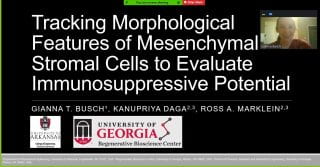 As a junior biomedical engineering student, I had already been working in Dr. Kyle Quinn’s lab for two semesters and had participated in a summer research program at the Vanderbilt Biophotonics Center. My passion for biomedical engineering research was already strong, and as such, I was looking forward to participating in another research program during the summer of 2020. I applied to several programs and was accepted to an REU at the University of Georgia. Dr. Ross Marklein reached out to me the day after I received the acceptance email. We had an excellent Skype call where we discussed the work his lab was doing and the potential projects he had available for summer students. After the call, he offered me a position in his lab through the program if I accepted the offer, which I immediately did. At this point I was already ecstatic at the prospect of working in his lab and applying the imaging techniques I had learned in Dr. Quinn’s lab to different problems, as well as exploring UGA’s campus.
As a junior biomedical engineering student, I had already been working in Dr. Kyle Quinn’s lab for two semesters and had participated in a summer research program at the Vanderbilt Biophotonics Center. My passion for biomedical engineering research was already strong, and as such, I was looking forward to participating in another research program during the summer of 2020. I applied to several programs and was accepted to an REU at the University of Georgia. Dr. Ross Marklein reached out to me the day after I received the acceptance email. We had an excellent Skype call where we discussed the work his lab was doing and the potential projects he had available for summer students. After the call, he offered me a position in his lab through the program if I accepted the offer, which I immediately did. At this point I was already ecstatic at the prospect of working in his lab and applying the imaging techniques I had learned in Dr. Quinn’s lab to different problems, as well as exploring UGA’s campus.
However, a week later the University of Arkansas cancelled classes for the remainder of the Spring 2020 semester due to COVID-19. Many other colleges were following suit and I wasn’t sure what to expect from my REU program. It was a tense few weeks waiting to hear what would happen, but throughout, Dr. Marklein was very supportive and reassuring. Eventually, the program announced that we would be participating virtually. Although I was looking forward to participating in person, I was happy that at least the REU had not been cancelled outright like so many other programs.
Dr. Marklein’s lab focuses on developing innovative approaches incorporating high-throughput, therapeutically relevant single cell profiling to assess cellular heterogeneity and accelerate translation of mesenchymal stromal cell (MSC) therapies. MSCs have significant potential to modulate the immune system and therefore, treat immune disorders such as multiple sclerosis and graft-versus-host disease. Despite promising preclinical data, clinical success has been elusive, potentially due to the inherent heterogeneity of MSCs. Although this heterogeneity is widely recognized, it is not yet well understood. In addition to the heterogeneity found in individual populations, it can also arise from differences in donor source and manufacturing conditions.
My summer project in Dr. Marklein’s lab was part of a larger effort to use functionally-relevant morphological profiling to evaluate morphological features of MSCs as potential critical quality attributes (CQAs) of immunosuppressive potential. Previous work on this project involved stimulating MSCs with interferon-gamma (IFN-γ), an inflammatory cytokine, before fixing and imaging a plate of cells every 15 minutes for 24 hours. The fixed-phase imaging data showed that distinct subpopulations did arise. However, the live phase imaging data from this study had never been analyzed. This provided the perfect project for me to be able to complete remotely while still developing new skills and learning more about a different field of biomedical engineering. I used CellProfiler to develop a pipeline which was able to track and quantify the morphological features of cells at each timepoint over the 24-hour period. I found that the live phase imaging data showed evidence of potential dynamic subpopulations emerging over the course of the study and that this approach could be generalized to other adherent cells responding to a functionally-relevant stimulus. I presented this work at the REU’s end-of-summer virtual symposium, which I also co-chaired. In addition, I gave a poster presentation at the 2020 BMES Annual Meeting over this work entitled “Tracking Morphological Features of Mesenchymal Stromal Cells to Evaluate Immunosuppressive Potential.”
As I have been going through the process of applying to graduate schools, I have kept in mind a piece of advice that I received: “Don’t think about where you want to be when everything is going well; think about where you would want to be when everything is going terribly.” Although this summer was not what I expected, Dr. Mao, Dr. Marklein, and everyone else who helped put the program together did their absolute best to make the REU as positive and enjoyable for us as possible. It was an incredibly valuable experience and I gained a lot from my participation in it. I was able to develop new technical skills and learn more about a field of biomedical engineering with which I was not yet familiar. Some programs simply weren’t able to transition to virtual delivery, but it was very reassuring to see how supportive and flexible the NanoBio REU faculty, staff, and graduate students were through the entire process. I encourage any undergraduate biomedical engineering students to apply to the 2021 NanoBio REU program (which is currently planned for in-person participation!) and the other excellent REU opportunities for biomedical engineers at the University of Georgia.
Please reach out to me if you have any questions about the program!
Jun 4, 2020 | Conference Diaries
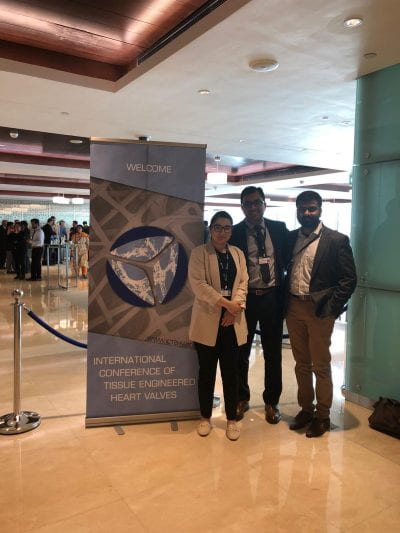
From left to right: Ishita Tandon, Kartik Balachandran, and Prashanth Ravishankar.
A University of Arkansas biomedical engineering professor and two doctoral students presented their cardiovascular research at the International Conference of Tissue Engineered Heart Valves in Abu Dhabi earlier this semester. The conference, ICTEHV for short, holds yearly meetings all over the globe to create a dialogue between researchers that might direct and/or translate engineered heart valve treatments. The researchers traveled to the conference before travel restrictions caused by COVID-19 were in place.
Ishita Tandon and Prashanth Ravishankar are both pursuing a PhD in biomedical engineering. Tandon’s primary research focus over the last few years has been on early stages of certain cardiovascular diseases, including how these diseases are diagnosed and treated. Ravishankar’s research concentrates on the structural scaffolding of heart valves and the issues presented by the engineering of such structures.
Both are attempting to tackle diagnostic and treatment methods for aortic valve calcification. This disease, which affects up to nearly a third of the aging U.S. population, can cause constriction from calcium deposits, leading to reduced blood flow in those afflicted.
Tandon and Ravishankar work alongside Associate Professor Kartik Balachandran in his mechanobiology and soft materials laboratory. Balachandran and his lab focus on bioengineering problems presented in cardiovascular diseases and specific neurovascular disorders. It is through Balachandran’s mentorship that led the two overseas to share their research with several hundred other engineers and clinicians.
Growing up in a family of doctors, Tandon said she always knew she wanted to work with biomaterials in some way.
“Unlike other kids, my childhood dream was to develop a skin graft artificially that my father, [a burn specialist], could transplant onto a patient,” she said.
During her presentation, Tandon discussed her findings on noninvasive, early diagnostic techniques for aortic valve calcification, research for which she currently holds a predoctoral fellowship from the American Heart Association.
“Calcific aortic valve disease currently has no drug-based therapy, no mitigation or prevention strategies resulting in valve replacement as the current treatment standard,” she said. “One major challenge in intervention strategies is lack of early detection.”
Tandon said she hopes to fill that gap by developing a set of metrics that allow for early detection and, as a consequence, enhanced treatment. She placed second in the Young Researcher Award for her presentation at the conference.
Ravishankar’s research, although similar in scope, differed in trajectory, focusing on the issues that might present itself in the replacement of calcified aortic valves. To show the realities of possible treatments, Ravishankar created a 3D environment mimicking the heart. This provided a blueprint of the pre-diseased valve so that the replacement tissues could later be engineered in laboratories.
Ravishankar noted that, in addition to the importance of his and others’ research, the conference presented an invaluable opportunity for networking with other engineers in similar disciplines.
“The most important thing personally for me was the fact that you receive excellent feedback from individuals who are highly renowned in the field that strengthens your research,” he said.
Just a few months earlier, Balachandran presented his collaborative research at the 17th International Conference on Biomedical Engineering in Singapore. That research, with help from technology provided by Associate Professor Kyle Quinn’s lab, focused on the sensitivity of select detection markers for aortic valve calcification. He presented an update of this work at ICTEHV in Abu Dhabi, one that focused on identifying the signaling mechanisms that maintain the aortic valve in its healthy, pre-diseased state.
“I am extremely proud of Ishita and Prashanth for their dedication and to Dr. Balachandran for actively promoting his students to conduct critical research to address cardiovascular diseases. I would also like to thank the Graduate School for their generous support to our students”, said Raj Rao, professor and department head of biomedical engineering.
Both students said they hope to push their research beyond the walls of the university. Ravishankar plans on pursuing industry so as to create lifesaving products. Tandon will continue with postdoctoral research in an effort to put the newest technologies on the market for consumers and improve patient care.
May 11, 2020 | Conference Diaries

Ishita Tandon and Olivia Kolenc are both PhD candidates for the Biomedical Engineering Department at the University of Arkansas. This past year they attended SWE’s yearly conference for women in California. Below they discuss networking benefits, memorable experiences, leadership knowledge, and awareness and ability to navigate challenges faced by minorities within the field of engineering.
Olivia Kolenc:
In November of 2019, I had the privilege of traveling to California to attend WE19, the Society of Women Engineers’ (SWE) largest conference to date. WE19 was held at the Anaheim Convention Center, filled with over 16,000 people ready to “Live, Learn, and Lead.”
I had yet to be a part of an event focused on women and diversity, so it was thrilling and inspiring to be surrounded by so many women and men dedicated to empowering women and minorities in STEM. I explored what WE19 had to offer, including sessions on a wide range of educational and professional development topics, an enormous career fair with over 400 attending organizations, special group meetings, and invitation-only programs such as SWE’s Collegiate Leadership Institute (CLI).
I have been a member of SWE since 2018 and currently serve as the vice-chair of the graduate student group on campus, GradSWE. Through my involvement with GradSWE, I was selected as one of 108 participants in SWE’s 2019 CLI. CLI is a program offered at each annual conference focused on helping undergraduate and graduate students develop their career and leadership skills.
The CLI program began with networking with other participants during WE19’s opening ice cream social and over dinner, where I got to know a few other graduate students. After having the opportunity to explore the conference, we were assigned mentees participating in the SWE Next High School Leadership Academy. I briefly mentored Alyssa, a high school sophomore. We spent a few hours together talking about her interest in robotics, the college application process, potential career paths, and interacting with industry representatives at the career fair.
On the final day of the conference, I attended a day-long CLI leadership colloquium. The colloquium sessions centered on providing us a framework to evaluate and discuss our strengths and weaknesses to learn what skills we as individuals needed to target to best enhance our educations and careers. We examined six competencies leaders need to develop for success and worked in groups to assess our progress in these areas. We also reflected on conventional leadership strategies, how they are currently changing, and how we can form a personal leadership structure based on leadership habits that work with our strengths. The colloquium culminated in small-table networking sessions with SWE leadership in various professional positions within, and outside, engineering.
Being part of CLI made attending WE19 much more significant to me. Not only did I garner so much new information on navigating the current challenges women and minorities face through the conference, but I also learned valuable strategies I can use to improve my own leadership abilities. After WE19, I was excited and energized to share what I learned through CLI and now have plans to conduct a leadership workshop for graduate students through GradSWE.
Ishita Tandon:
Four of the officers from Uark Graduate SWE RSO attended the We19, the annual conference of SWE. I have been involved with Grad SWE at Uark since 2018. I first served as the communications chair in the inaugural committee and then as the financial chair this past year. We have dedicated our RSO to hold professional and personal development events and social/ networking gatherings for Uark Students.
Some of the events which stood out to me were “I Have a PhD in Engineering – Now What?”, “Mentoring in Graduate School Panel”, “Strategies for Applying for a Job in Academia”. While I was more interested in professional development workshops, We19 offered leadership development, collegiate competitions, career fairs and social nights too. I had the opportunity to know a lot about industry careers in R&D after pursuing PhD. I also had the chance to meet and network with the SWE graduate leadership team and discuss with them opportunities for involvement and collaborations.
This also opened the door for me to apply to the We Local Collegiate competitions. I was shortlisted as one of the 5 finalists to present my research in form of a talk and a poster at the We Local held in Salt Lake City in February, 2020. I was honored with $250 award, certificate and SWE swag for the same. The We Local, Salt Lake had a small group of men and women focused on professional development and networking. There were many workshops and seminars offered including “to post doc or not to post doc”, “resume workshop”, “flexibility in communication styles and a lot more.
Apart from deep appreciation and feedback offered on research presentations, I had two packed days of learning tips and tricks for enhancing my career, our SWE group and networking and making friends as well. The socials had professional, collegiate members and the leadership and organizing team, all enjoying food, games and good conversations. Indeed, the keynote speeches about an undergraduate’s journey from internship in NASA to Miss America pageant and a crew member of “The Maiden” which was featured in the documentary of the same name in 2018, were highly motivating. This whole experience inspired me more towards being involved in student organizations, enhance my leadership skills, appreciate the opportunities coming our way and strive for more. I hope to stay connected with the SWE strive towards further extending these opportunities to more women and underrepresented students from UARK.
Mar 5, 2020 | Conference Diaries

Pictured above: various educators and researchers, including organizers, invited to the conference.
Associate professor Kartik Balachandran of biomedical engineering presented his collaborative research findings at the 17th International Conference on Biomedical Engineering, ICBME for short, this past December.
An invited speaker, his talk focused on the sensitivity of select markers that determine calcific aortic valve disease progression. These findings were part of a collaborative project with associate professor Kyle Quinn’s lab, which pinned down early markers of the disease. His talk was titled, “Two Photon Excited Fluorescence Microscopy Metrics Are Sensitive to Early Phenotypic Changes in Calcific Aortic Valve Disease in Vitro and Ex Vivo.”
Balachandran found the conference to be both memorable and imperative to the outreach of researchers in the field of biomedical engineering who are working to develop and spread novel biomedical technologies. 600 participants were present, spanning a total of 30 countries; such demographics show the extent of such scientific outreach.
The ICBME is a four-day annual conference organized by the Biomedical Engineering Society in Singapore. They’re considered one of the most recognized conferences worldwide that provide “the latest developments including emerging challenges faced in the advancement of the Biomedical Engineering sector.”
Balachandran was also invited to present this research at the International Conference of Tissue-Engineered Heart Valve and Heart Valve Society Meeting in Abu Dhabi on February 14, in addition to two of his doctoral students. A Newswire on this conference is forthcoming.
Apr 23, 2019 | Conference Diaries
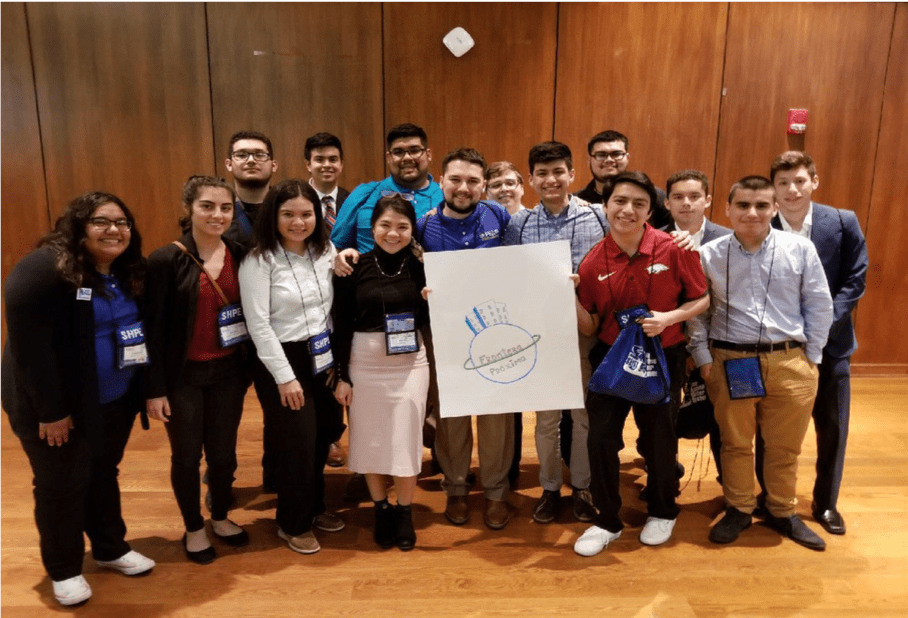
Engineering competition at the RLDC 2019. The winners were University of Arkansas, University of Texas at Austin and University of Texas at Arlington.
Alexandra Gutierrez is an undergraduate studying biomedical engineering. Below, she recounts her experiences at the Regional Leadership Development Conference held by the Society of Hispanic Professional Engineers.
My name is Alexandra Gutierrez, I am a senior biomedical engineering student and it was not until my junior year that I realized the importance of being involved with the different RSO on campus. I am currently part of the Panamanian Student Organization (PSO), American Indian Society of Sciences and Engineering (AISES), and the Society of Hispanic Professional Engineers (SHPE).
In particular, I would like to share my experience at Regional Leadership Development Conference (RLDC) 2019, organized by SHPE and held at St. Mary’s University, University of Texas in San Antonio, TX. Soaring for success was the Conference’s main theme. At this conference, not only was I exposed to meeting new people, participating in an engineering competition, a protagonist of the multiple workshops held by SHPE to develop leadership skills, and part of a career fair for networking opportunities, but also RLDC participants were fully inspired to impact the community through STEM as well as guided by experienced leaders. At this conference, there were many interesting workshops, but the most relevant workshop sessions for me were: “SHPEOLOGY” and “Hacking Your Professional Brand While Being Authentic”. “SHPEOLOGY” was conducted by Monique Herrera, the corporate director of relations and marketing of SHPE. In SHPEOLOGY, she explained that the Hispanic community in the workplace is reduced because there is a lack of knowledge from Hispanic people about the professional and leadership opportunities that are offered for Hispanics every year. Thus, it is important for more Hispanics to join this “Familia”, as she called it. Here, they can access these opportunities more easily. Raising awareness about the values and diversity Latinos to bring to places, such as the workplace and academia, might be an effective solution to diverse problems this society faces. With this solution, she invites every Hispanic to strive for the best and never give up while joining this organization to spread the word.
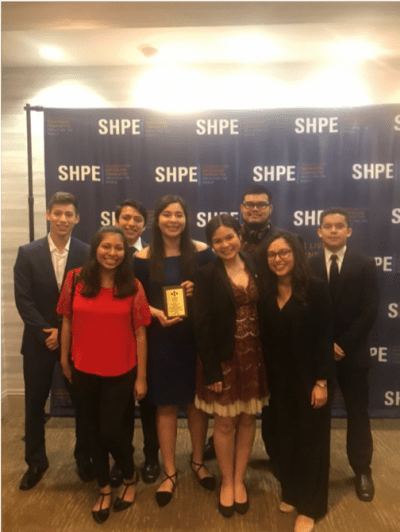
The University of Arkansas chapter was recognized as the most improved chapter in the region.
The other workshop was named: “Hacking Your Professional Brand While Being Authentic”, Rodney Tobares, the speaker from the Facebook Company. His message was based on building a community to bring more Latinos/Hispanics closer together through technology. During his years at the industry, he relied on the power of becoming his own brand, and he encourages everyone to do the same. Collectivism, sympathy, respect, cultural identity, fatalism, and paternalism have been the Latino cultural strips from which he has used to share his Hispanic heritage. He mentioned that we need to have defined steps in order to reach our goals. He suggested a platform called “Piazza”, which is designed to connect professionals and academia. The career fair was also an important component of this conference. Here, Hispanics were able to interact with professionals from a variety of companies, give their elevator pitch, and be led by professionals to their possible industry interests as well as academic paths.
Overall, these workshops brought more awareness to me and my desire to invite everyone to join this society while in college. I am thankful for having had the support from the BME department. Hispanics and any individual can benefit from events like this conference, and others such as the National conference coming in the fall of this year. Come and be part of our Familia!
Mar 12, 2019 | Conference Diaries
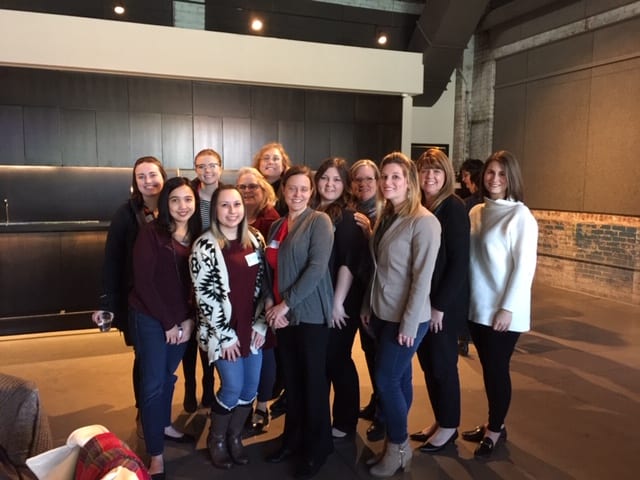
Pictured above: UAF engineering staff at Women in the Workforce Annual Conference on March 6, 2019 in Bentonville, AR
As part of Women’s History Month, Tori Marie Stover—Fiscal Support Analyst for the Biomedical Engineering Department—offers a summary of the Women in the Workforce Annual Conference held on March 6, 2019 and the various sessions that were presented.
The theme of this conference was Purpose, Performance, and Persuasion. Their description: “This one-day, interactive conference provides female professionals with an opportunity to enhance relevant workplace skills. Hear from industry veterans on topics that align with this year’s theme.”
Keynote Speaker:
“This thought-provoking session on leadership style specifically is geared towards women, focused on 6 Key P’s: Performance, Persuasion, Purpose, Passion, Presence, and Perception.”
- The first session was with Keynote Speaker Merrissa Pires, VP of Human Resources at Rickett Benckiser. We were asked to speak with another attendee about who we are at our best and worst, and how we remain our best during our worst times. This allowed us to reflect on who we really are, and made us think about our passions, and what makes us feel powerful. She asked us to think about how a child would perceive us; children tend to see greatness in everything, which was very thought provoking. Then she provided us with a quote, “Gallup analysis reveals that people who use their strengths (passions) every day are three times more likely to report having an excellent quality of life, six times more likely to be engaged at work, 8% more productive and 15% less likely to quit their jobs.” This engrains that how we perceive ourselves, and the things we are passionate about, have a huge impact on us. With that said, she pointed out that women often tear themselves down, when they should be lifting themselves up. This is a great reminder for anyone; your quality of life matters, and you shouldn’t be so hard on yourself.
Workshop:
- We chose between two workshops: Discover Your Purpose: Emi Cardarelli, Director Club Sales and Sustainability at Unilever and Discover and the Impact of Storytelling in the Workplace: Shannon Petersen, Director of Human Resources at Hilti. I chose to attend the latter, since the former sounded similar to the keynote speaker, and I wanted to learn something different. This presentation’s purpose was to give us a deeper understanding of the power of storytelling and how to use it to connect with co-workers, customers, and supervisors. Shannon shared her story of a medical scare that forced her to spontaneously go on short-term disability leave, and how her supervisor was supportive and encouraged her to come back to work afterwards. By the end of the story, the whole audience felt a connection to Shannon and her experience. As an exercise, she had one half of the room ask each other a set of questions, then the other half answer a different set. The first half were simple questions about favorite actors, and pets, while the second half was about our goals and other personal questions. Her point was that the more complex and personal a question or story is, the more in-depth the answer or reaction will be. As a result, you will feel more connected to the other person. She uses this method to hire employees, or sell a product, but it can be used in any situation where you are interacting with another individual.
Panel Discussion:
- Silvia Siqueria, Diversity and Inclusion Officer at Hilti, brought a panel of presenters to discuss the importance of workplace diversity. At first, they began with gender diversity, but it quickly began to include age and race as well. They answered several questions from the audience about how to handle situations, ranging from what to do when someone is clearly excluding you for being different than them, to when someone is trying to make you comfortable, but ends up making you more uncomfortable. The example given for the latter was, an African American woman had started a position and had items removed from her list of duties, because her supervisor didn’t think she would be comfortable handing it. All of the responses were thoughtful, but the most helpful piece of advice, was to write it down and have a conversation about it later. Tell them how it made you feel and ask if this was their intention. Silvia said from her experience doing this, she usually gets the response, “Of course not, I didn’t even think about it that way”. This opens a dialogue about the issue, and allows the other person to understand how their words or actions can be misconstrued, so they can be more thoughtful about the way they behave in the future. I think this piece of advice can be helpful to anyone who is having a conflict with a co-worker or supervisor.
The day ended with a drawing for some goodies, and closing words by the MC, Kristy Meinzer, Senior Manager of Performance Content, and VMLY&R.
 As a junior biomedical engineering student, I had already been working in Dr. Kyle Quinn’s lab for two semesters and had participated in a summer research program at the Vanderbilt Biophotonics Center. My passion for biomedical engineering research was already strong, and as such, I was looking forward to participating in another research program during the summer of 2020. I applied to several programs and was accepted to an REU at the University of Georgia. Dr. Ross Marklein reached out to me the day after I received the acceptance email. We had an excellent Skype call where we discussed the work his lab was doing and the potential projects he had available for summer students. After the call, he offered me a position in his lab through the program if I accepted the offer, which I immediately did. At this point I was already ecstatic at the prospect of working in his lab and applying the imaging techniques I had learned in Dr. Quinn’s lab to different problems, as well as exploring UGA’s campus.
As a junior biomedical engineering student, I had already been working in Dr. Kyle Quinn’s lab for two semesters and had participated in a summer research program at the Vanderbilt Biophotonics Center. My passion for biomedical engineering research was already strong, and as such, I was looking forward to participating in another research program during the summer of 2020. I applied to several programs and was accepted to an REU at the University of Georgia. Dr. Ross Marklein reached out to me the day after I received the acceptance email. We had an excellent Skype call where we discussed the work his lab was doing and the potential projects he had available for summer students. After the call, he offered me a position in his lab through the program if I accepted the offer, which I immediately did. At this point I was already ecstatic at the prospect of working in his lab and applying the imaging techniques I had learned in Dr. Quinn’s lab to different problems, as well as exploring UGA’s campus.





